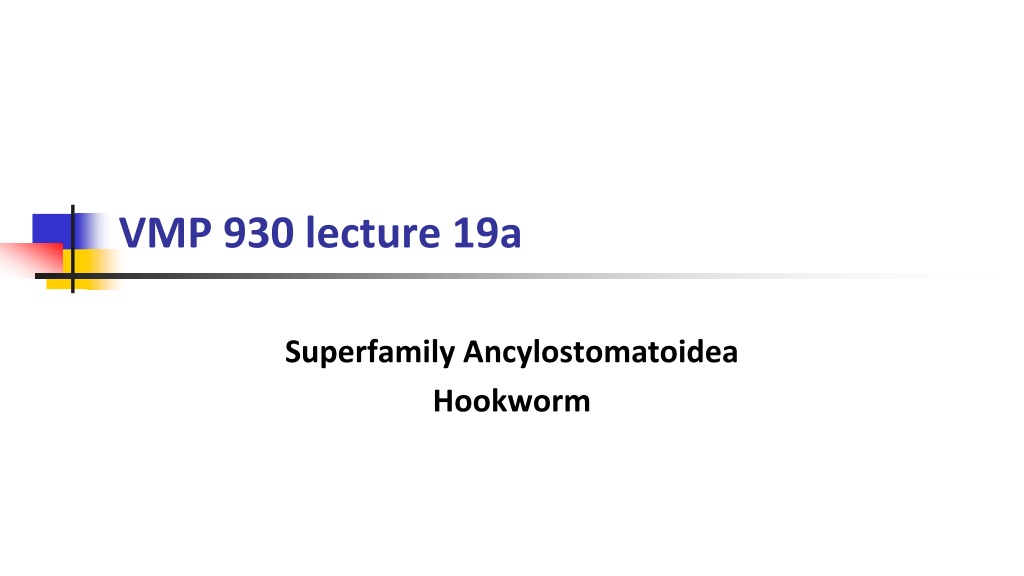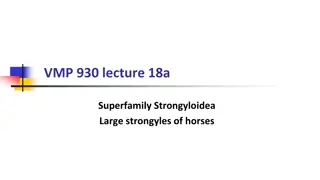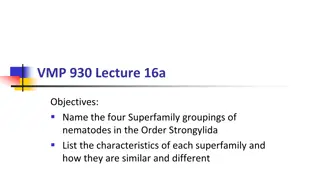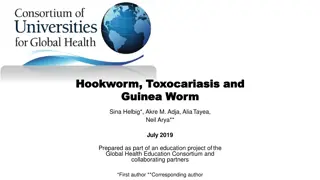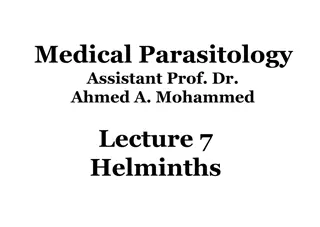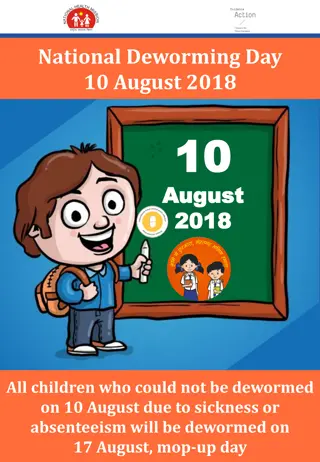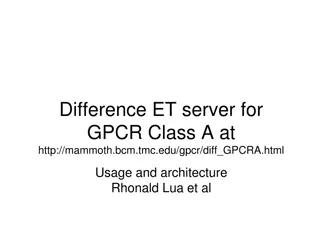Understanding the Hookworm Superfamily Ancylostomatoidea
The superfamily Ancylostomatoidea includes blood-feeding parasites like hookworms, with important species such as Ancylostoma caninum in dogs and Ancylostoma duodenale in humans. These parasites have a complex lifecycle involving transmission through the environment and development within the host. Ancylostoma caninum, prevalent in dogs, poses a significant health risk with potential morbidity and mortality. Understanding the morphology, pathogenesis, ecology, and transmission of hookworms is crucial for effective management and prevention.
Download Presentation

Please find below an Image/Link to download the presentation.
The content on the website is provided AS IS for your information and personal use only. It may not be sold, licensed, or shared on other websites without obtaining consent from the author. Download presentation by click this link. If you encounter any issues during the download, it is possible that the publisher has removed the file from their server.
E N D
Presentation Transcript
VMP 930 lecture 19a Superfamily Ancylostomatoidea Hookworm
Order Strongylida Superfamilies: Trichostrongyloidea Strongyloidea Metastrongyloidea Ancylostomatoidea (hookworms)
Ancylostomatoidea Lumen of small intestine Note blood caused by feeding hookworms adult worm HOOKWORMS Adults dorsally flexed anterior Buccal cavity w/ cutting teeth or plates 10-16 mm long Infect the host s small intestine Anterior of hookworm Note buccal cavity with teeth
Morphology Ova morphology Anterior morphology Strongyle-type eggs in dog or cat feces = HOOKWORM eggs TEETH CUTTING PLATES Ancylostoma Uncinaria
Ancylostoma species of importance Ancylostoma caninum --- DOGS Ancylostoma tubaeformae --- CATS Ancylostoma braziliense --- DOGS & CATS Ancylostoma duodenale --- HUMANS
Ancylostoma caninum SOUTH-EASTERN STATES, most prevalent enteric helminth in dogs ~20-40% in shelter dogs
Blood-feeding parasites Morbidity and potential mortality!
A. caninum: Pathogenesis Ancylosotma caninum adult taking a bloody bite of mucosa!
A. caninum: Ecology Egg 5-7 days in warm, moist soil L1 L2 L3 Infective L3 larva
A. caninum: Transmission Infection from the environment by: Ingestion of L3 Skin penetration by L3 (Ingestion of paratenic host)
Development within the host Two choices for an L3 larva after entering host: 1. NORMAL DEVELOPMENT L3 L4 Adult OR 2. ARRESTED DEVELOPMENT ( hang out as L3 in muscle, organs)
Development within the host When do arrested L3 larvae reactivate? DEWORMING STRESS PREGNANCY REACTIVATION of tissue-arrested L3s REACTIVATION of tissue-arrested L3s SELF-REPOPULATION L3 to adult stage in small intestine TRANSMAMMARY TRANSMISSION L3 in milk to pups (but not kittens)
Transmammary transmission Migration to mammary glands Transmission in milk to nursing pups during lactation Experimental observation: 1 infection of dam can contribute to transmission of infection to at least 3 subsequent litters!
Getting rid of arrested larvae? metabolically quiescent relatively resistant to host defense mechanisms and to drugs negative fecal analysis ?
Ancylostoma transmission What are the different ways by which dogs and cats can acquire Ancylostoma infections? Ancylostoma caninum Ancylostoma tubaeformae Primary route is lactogenic No lactogenic transmission in cats Ingestion from environment Primary is ingestion from environment Skin penetration from environment
Pathogenesis & Clinical signs Adult worms are blood-feeders need oxygen/nutrients Consequences to the host: ANEMIA BLOODY DIARRHEA
Pathogenesis Hemorrhage: bite sites continue to bleed (Why does blood not clot?) Some damage to intestinal mucosa Larval migrations may cause some pathology (e.g. respiratory signs but this is not common)
Clinical Disease Acute anemia in nursing puppies PCV down to 10+% from 35-57% (normal) Blood loss from 50-100 adults ~3 ml/day Mortality between 8 and 24 days of age Chronic disease: weight loss, poor body condition, especially in older or immunocompromised animals Clinical disease very common in dogs but not in cats
Host resistance - Adult dog acquired immunity (not complete) prone to re-infection premunition (inhibition of further infection due to residual population) ability to compensate for blood loss
Treatment & Control Warm, moist conditions favor L3 survival, do not tolerate desiccation Newly emerging multi-drug resistant Ancylostoma caninum. Seen in mature dogs. Originally rescue Greyhounds. Newborns TREAT with anthelmintic at first sign of disease (Improvement = Diagnosis) +/-BLOOD TRANSFUSION +/- Iron supplementation, vitamins, protein
Treatment & Control Puppies: deworm every 2-3 weeks, until starting monthly heartworm preventative Keep runs clean and dry; bleach washes
Treatment & Control Treating pregnant dogs to prevent infections in puppies Fenbendazole - every day from day 40 of gestation to day 14 of lactation (~ 40 days!) Selemectin and possibly other monthly avermectin prophylactic drugs timed to coincide with whelping. Much easier than above
Zoonosis Infective L3 can penetrate human skin and cause cutaneous larva migrans erythematous pruritis A. braziliense; A. caninum
Uncinara sp. less common hookworm of dogs found in cooler temperate regions relatively non-pathogenic only infected by ingestion of L3 (no transmammary transmission)
VMP 930 lecture 19b Order Oxyurida Oxyuris equi (pinworm of horses)
Order OXYURIDA Pinworms of the large intestine Adult worms have long tapering tail Worm most often seen by horse owner Host-specific Enterobius is a human pinworm Cats and dogs do NOT have pinworms Horses: Oxyuris equi
Oxyuris equi Long tapering posterior large, white, thick-bodied adults
Oxyuris equi Life Cycle Host: Horses Adult female in large intestine, migrates to the anus and deposits eggs in a sticky fluid on perianal area Fluid dries and flakes off with eggs contaminating food and water containers Infective L3 mature within the eggshell in 4-5 days; ingested by the horse L3s in large intestine mature to adulthood Prepatent period ~ 5 months
Oxyuris equi Pathogenesis & Clinical Signs Large numbers of adults and developing L4 - L5 larvae in the large intestine cause colitis Eggs/sticky fluid cause perianal itching and a bare or scruffy tailhead
Oxyuris equi Diagnosis operculum scotch-tape pressed around previously cleaned perianal area; examine for operculated eggs Eggs w/ single operculum embryo
Oxyuris equi Treatment Benzimidazoles (fenbendazole) recommended Drug resistance to avermectins including ivermectin and moxidectin.
